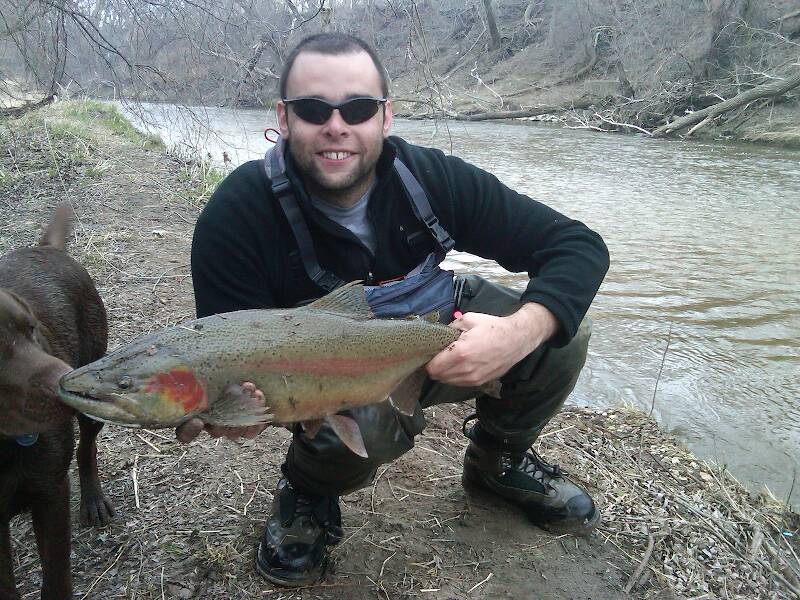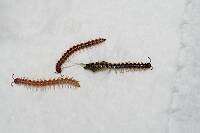
Hex Mayflies
Hexagenia limbata
The famous nocturnal Hex hatch of the Midwest (and a few other lucky locations) stirs to the surface mythically large brown trout that only touch streamers for the rest of the year.
Featured on the forum

This one seems to tentatively key to Holocentropus, although I can't make out the anal spines in Couplet 7 of the Key to Genera of Polycentropodidae Larvae nor the dark bands in Couplet 4 of the Key to Genera of Polycentropodidae Larvae, making me wonder if I went wrong somewhere in keying it out. I don't see where that could have happened, though. It might also be that it's a very immature larva and doesn't possess all the identifying characteristics in the key yet. If Holocentropus is correct, then Holocentropus flavus and Holocentropus interruptus are the two likely possibilities based on range, but I was not able to find a description of their larvae.

Troutnut is a project started in 2003 by salmonid ecologist Jason "Troutnut" Neuswanger to help anglers and
fly tyers unabashedly embrace the entomological side of the sport. Learn more about Troutnut or
support the project for an enhanced experience here.
Kschaefer3 on Aug 23, 2013August 23rd, 2013, 7:24 am EDT
The thread on inch worms got me thinking about trout selectivity. How do you determine what trout are selectively feeding on? When I fished the trico hatch, it was pretty easy to tell they were going to town on trico spinners. How do you figure out that they feed selectively on inch worms? I am sure there are other "non standard" items that trout occasionally feed selectively on that one would never know without some other information (ie seeing the fish eat, insider info, examining stomach contents).
This all leads to my, somewhat, main question. Does anyone pump trouts stomachs? I have never done so, but have thought it would be interesting and may make me privy to feeding patterns that others don't know about. I like knowing things others don't...especially when it come to fishing. Does pumping their stomach hurt trout at all?
I practice C&R almost exclusively for trout. I have kept two fish in the last two years and both died while trying to revive them. However, I do not believe that harvesting fish on occasion will have any significant impact on the river and its trout population. Because of this, I have thought about keeping a fish once in a while to check their stomach and subsequently eat them. I think trout are delicious.
If pumping their stomach is not harmful, which seems unlikely, I would consider pumping stomachs to get a better idea of feeding habits. If it is harmful, I may keep a fish every now and then to check their stomachs.
I am curious what others opinion on the matter is. Are there other methods you employ to figure out what trout are eating?
This all leads to my, somewhat, main question. Does anyone pump trouts stomachs? I have never done so, but have thought it would be interesting and may make me privy to feeding patterns that others don't know about. I like knowing things others don't...especially when it come to fishing. Does pumping their stomach hurt trout at all?
I practice C&R almost exclusively for trout. I have kept two fish in the last two years and both died while trying to revive them. However, I do not believe that harvesting fish on occasion will have any significant impact on the river and its trout population. Because of this, I have thought about keeping a fish once in a while to check their stomach and subsequently eat them. I think trout are delicious.
If pumping their stomach is not harmful, which seems unlikely, I would consider pumping stomachs to get a better idea of feeding habits. If it is harmful, I may keep a fish every now and then to check their stomachs.
I am curious what others opinion on the matter is. Are there other methods you employ to figure out what trout are eating?
PaulRoberts on Aug 25, 2013August 25th, 2013, 8:43 pm EDT
I do pump. I once asked a fish pathologist if this would harm fish and he nearly scoffed, "No! As long as you don't damage tissue there's no problem flushing a fish's stomach with stream water."
I made my own pump using Nalgene tubing and a latex rubber squeeze bulb connected with a double ended tube fitting. I made two tubes of differing diameters for small and large trout. I tapered the end of each tube so that they could be inserted between jaws more easily. The bulb can be pulled off and popped onto either tube. I drilled a hole in the fitting rim to affix a retractor to it. The entire deal retracts from under my vest so it's out of the way while fishing but handy when I'm crouched over a fish.
Inchworms: Never seen a fish "selective" to inchworms (practically speaking I think of "selective" as being exclusive, or myopic, to certain insects, stages, or locations in the water column). But I have seen trout well aware of, even having developed a "search image" for inchworms. This happens in early summer in NY and PA in forested streams when inchworms are hanging from threads all over the forest. Many fall into the streams and trout can become hyper-aware of them. You know that is the case when the fish move a long ways for your fly. I once had a 14+" upper Hammersley brown bolt several feet cross current for the yellow tag of a Panther Martin spinner. Sadly I killed the fish for dinner (this was years ago), and it was packed with bright chartreuse inchworms.
In appropriate places I still kill trout for the pan (would never kill such a fish on the Hammersley nowadays) and always check their stomachs. I've posted some stomach contents here on Troutnut. Pumping is only so effective and results vary. I've pumped fish before I've killed them, just to see. I do miss a lot, collecting usually things most recently ingested (helpful info in the moment), medium sized individual items, and miss large intact items (crayfish), and tiny or partially digested compacted items. I only pump once, or maybe twice, and am careful to get it right the first time. I'm not willing to abuse fish I'm going to release. You never get it all. If you really need to recover all, kill the fish. Sometimes I do want to recover all bc it gives a day's chronolgy which can prove interesting.
My protocol:
-Draw in approp volume of water for the fish.
-Insert gently and deeply (I believe to end of esophagus or partially into stomach). Don't force it.
-Squeeze some water in and out a few times to loosen things up in there, then release bulb entirely to draw stuff out.
-Pull tube out (and bulb will fully open).
-Squeeze water and contents out into my hand in small amounts so I get to see it all.
-Then draw more stream water into bulb and squeeze and rinse tube into my hand again to recover more from the bulb. Will likely take a few rinsings. Seems there's always a midge or two left behind.
-I then wash out bulb aggressively so as not to contaminate following samplings, and to clean it.
I made my own pump using Nalgene tubing and a latex rubber squeeze bulb connected with a double ended tube fitting. I made two tubes of differing diameters for small and large trout. I tapered the end of each tube so that they could be inserted between jaws more easily. The bulb can be pulled off and popped onto either tube. I drilled a hole in the fitting rim to affix a retractor to it. The entire deal retracts from under my vest so it's out of the way while fishing but handy when I'm crouched over a fish.
Inchworms: Never seen a fish "selective" to inchworms (practically speaking I think of "selective" as being exclusive, or myopic, to certain insects, stages, or locations in the water column). But I have seen trout well aware of, even having developed a "search image" for inchworms. This happens in early summer in NY and PA in forested streams when inchworms are hanging from threads all over the forest. Many fall into the streams and trout can become hyper-aware of them. You know that is the case when the fish move a long ways for your fly. I once had a 14+" upper Hammersley brown bolt several feet cross current for the yellow tag of a Panther Martin spinner. Sadly I killed the fish for dinner (this was years ago), and it was packed with bright chartreuse inchworms.
In appropriate places I still kill trout for the pan (would never kill such a fish on the Hammersley nowadays) and always check their stomachs. I've posted some stomach contents here on Troutnut. Pumping is only so effective and results vary. I've pumped fish before I've killed them, just to see. I do miss a lot, collecting usually things most recently ingested (helpful info in the moment), medium sized individual items, and miss large intact items (crayfish), and tiny or partially digested compacted items. I only pump once, or maybe twice, and am careful to get it right the first time. I'm not willing to abuse fish I'm going to release. You never get it all. If you really need to recover all, kill the fish. Sometimes I do want to recover all bc it gives a day's chronolgy which can prove interesting.
My protocol:
-Draw in approp volume of water for the fish.
-Insert gently and deeply (I believe to end of esophagus or partially into stomach). Don't force it.
-Squeeze some water in and out a few times to loosen things up in there, then release bulb entirely to draw stuff out.
-Pull tube out (and bulb will fully open).
-Squeeze water and contents out into my hand in small amounts so I get to see it all.
-Then draw more stream water into bulb and squeeze and rinse tube into my hand again to recover more from the bulb. Will likely take a few rinsings. Seems there's always a midge or two left behind.
-I then wash out bulb aggressively so as not to contaminate following samplings, and to clean it.
Kschaefer3 on Aug 26, 2013August 26th, 2013, 7:48 am EDT
Thanks for all the great info, Paul!
I fish a lot of wooded spring creeks and I bet the trout there eat inch worms too. I would also bet they eat many other things I'm too stupid to think of. I think I'm going to get a pump to combat my shortcomings.
I still do like the idea of occasionally killing a fish to get the full contents of their stomach. What is your criteria for killing trout? Some of the creeks I fish have many thousands of fish
I fish a lot of wooded spring creeks and I bet the trout there eat inch worms too. I would also bet they eat many other things I'm too stupid to think of. I think I'm going to get a pump to combat my shortcomings.
I still do like the idea of occasionally killing a fish to get the full contents of their stomach. What is your criteria for killing trout? Some of the creeks I fish have many thousands of fish
Entoman on Aug 26, 2013August 26th, 2013, 2:08 pm EDT
Inchworms: Never seen a fish "selective" to inchworms...
I have, but it's one of those "hatches" that you tie specific flies for only not to find them significant again for years. I've got hundreds of patterns in my collection that fit into that category.:)
"It's not that I find fishing so important, it's just that I find all other endeavors of Man equally unimportant... And not nearly as much fun!" Robert Traver, Anatomy of a Fisherman
PaulRoberts on Aug 26, 2013August 26th, 2013, 6:14 pm EDT
... What is your criteria for killing trout? Some of the creeks I fish have many thousands of fish that I can't imagine it having any significant impact.
Many factors both biological and social. Common sense really. If it's a trout factory it can give some up and I have no problem taking some. I don't kill large fish, bc I and others want to catch them again. Although in many streams -esp marginal ones- when fish near the top end, they get thin and begin to fail. I can see culling a few of those. But, it helps to know the stream's conditions well over time bc many streams will have limited periods (summer drought often) when fish get thin but pick up again after.
...it's one of those "hatches" that you tie specific flies for only not to find them significant again for years. I've got hundreds of patterns in my collection that fit into that category.:)
Kurt, problem is you just that you don't get out enough! :)
Entoman on Aug 26, 2013August 26th, 2013, 6:20 pm EDT
LOL - That's what I told my wife the last time I saw her... Early May? :)
"It's not that I find fishing so important, it's just that I find all other endeavors of Man equally unimportant... And not nearly as much fun!" Robert Traver, Anatomy of a Fisherman
TNEAL on Aug 27, 2013August 27th, 2013, 8:44 am EDT
Regarding selectivity to inchworms....
It does happen. I was caught by this years ago on one of my favorite Northern Michigan streams. Wind blew them onto the water and, all of a sudden, a "lifeless" stretch had half a dozen fish smashing the surface and ignoring everything I had. They were so intent on feeding that I approached to within 12 feet or so of a brown in the 20" range and just watched him feed. No inch worm imitations; no fish.
Tim
It does happen. I was caught by this years ago on one of my favorite Northern Michigan streams. Wind blew them onto the water and, all of a sudden, a "lifeless" stretch had half a dozen fish smashing the surface and ignoring everything I had. They were so intent on feeding that I approached to within 12 feet or so of a brown in the 20" range and just watched him feed. No inch worm imitations; no fish.
Tim
Quick Reply
Related Discussions
Topic
Replies
Last Reply
12
Nov 2, 2015
by Troutnut
by Troutnut
Re: Best of the Forum--Most Useful and Informative Bug Threads Featured Topic
In General Discussion by Martinlf
In General Discussion by Martinlf
17
Feb 26, 2016
by Crepuscular
by Crepuscular
9
Dec 1, 2014
by Stewart711
by Stewart711





